#Erin Espelie
Explore tagged Tumblr posts
Text
Gallery Spotlight: Aida Jones
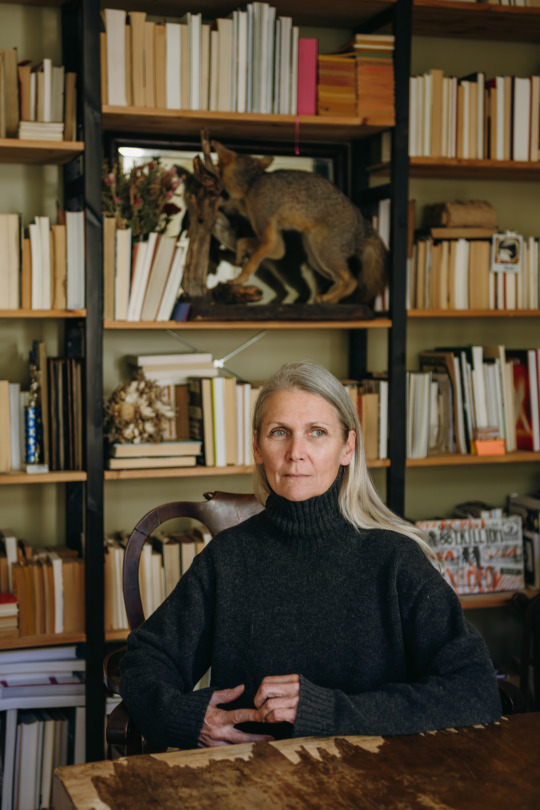
We at Studio AHEAD are excited to announce our latest exhibition, The Lily Too Shall Function, on display at The Jones Institute and the Minnesota Street Project starting November 3. As a sneak peak, we spoke this month with Aïda Jones, founder of The Jones Institute, who shared with us the history of the home gallery, a few thoughts on our show, and what San Francisco was like in the 1990s.
Studio AHEAD: The first striking thing about the Jones Institute is that it is run out of your living room. Can you share with us the history of how this came to be?
Aïda Jones: Impulse was the catalyst. An artist friend was forlorn after being rejected by a gallery and, instinctively, I responded, “I’ll have a show for you.”
It was a leap of faith where Matt Dick, Ruth Kneass, Tjarn Sato, Fletcher, Anton Stuebner, Michael Lee, Wendy Norris, Regina Tsasis, and many many others, generously helped transform my living room into The Jones Institute.
Studio AHEAD: Were there other contexts?
Aïda Jones: The home is the original gallery. We still visit homes—the Uffizi, the Louvre, the Frick—that are now museums. The Walker Art Center in Minneapolis began in TB Walker’s home in the late 19th century and in New York in the 50s, Leo Castelli converted his living room into his first gallery. The New York Times had a wonderful article about apartment galleries a few years back.
Studio AHEAD: Perhaps 500 Capp is San Francisco’s most famous example. Who were your guiding lights in setting this up?
Aïda Jones: I love the idea of shaping culture from the fringes. Of bringing a traditional and formal construct into the domestic space.
Guiding lights are everywhere. Walk out your door and you’ll find thousands of inspirations: the drunk at the wharf, everything in Chinatown, the dahlias in the park, the art in the TL, vendors in the Mission, the cook at Red’s, the amateur opera singer next door rehearsing.
Studio AHEAD: What sort of advantages does this… let’s say DIY approach… bring?
Aïda Jones: Let's not say DIY.
Studio AHEAD: Then what would you call it? Certainly the space itself affects how people view the art.
Aïda Jones: If we have to label it, maybe call it an alternative space. And you’re right, space absolutely affects how people view art. It permeates every bit of their experience. When art is in a home, the sense of place opens them up—the art itself changes the space, it’s a symbiotic relationship you won’t have within the white box. And The Jones Institute is not a commercial place so most people find communing with art is different.
Studio AHEAD: Tell us about a recent exhibition from curator Shirley Watts. Would this be a show a more mainstream gallery could put on?
Aïda Jones: Yes and no. While individually the artists from that show (Gail Wright and Megan Gafford, for example) are exhibited in mainstream galleries, the whole of Altered States would have been impossible. Where else could you sit in a backyard, listening to an audio performance of a brain dissection (Erica van Loon) after taking in Megan Gafford’s irradiated daisies and an Erin Espelie RGB video in the main gallery?
Studio AHEAD: Nowhere else! How does our show, The Lily Too Shall Function, fit into this?
Aïda Jones: The Lily Too Shall Function, being guest curated by Homan and Elena, feels very connected to our programming. First, they chose three Northern California artists among the cohort we choose to exhibit here; and second, they are working their distinct point of view within the domestic space, marrying art with how we live. Very much in our founding ethos. We also have a deep belief in sharing the artistic process, so screening a film of the artists at our satellite location in Minnesota Street Project just makes sense.
Studio AHEAD: You and Homan were speaking off-the-record about the 1990s, on which there is currently a lot of nostalgia in mainstream American culture. What elements of the 90s would you like to see transplanted into the 2020s?
Aïda Jones: This is specific to San Francisco where we are on the edge of the world. The experimentation, the casual spontaneity, the lack of preciousness and belief you could do anything.
In the 90s, I founded AvidFan, a theatre company, and when I cast two actors (who were also female) in The Zoo Story and then True West—this to the New York Times was radical, but in San Francisco, no one blinked.
It happened because of this place as it existed then. The space and freedom. The whole Bay was wide open with possibility (and low rents!). Such amazing support for artists, from studios and rehearsal spaces for musicians, filmmakers, comedians, photographers, spoken word poets, writers, hip-hop/modern/ballet dancers to performance venues and theaters (& a cowboy store on Valencia), many underground & well-known support structures like Film Arts Foundation, New Langton Arts, New College, and so many others.
For a peek into that era see the New Yorker article of the photographer Chloe Sherman’s Renegades (and then buy the book).
Studio AHEAD: What aspect of the 2020s would you have liked to see back in the 90s?
Aïda Jones: The lovely, well-kept city parks. The absence of lingerie shows in downtown bars.
Studio AHEAD: We like to end with some cultural spaces/people in Northern California you’d like to shed light on.
Aïda Jones: Aside from each and every artist I've shown?
Studio AHEAD: Yes.
Aïda Jones: Here is an incomplete list: Aimee Sioux, Reed Awakening, TamaOne, The Farm Stand Art & Music program, Stud Country Queer Line Dancing, Slash Art, For You, the Bolinas Museum, African American Cultural Center, Dancers' Group, Auntie Charlie’s, Werkshack, CCSF Film Department, Arborica, the promise of a NorCal Pacific Standard Time, Catholic Charities’ homeless family shelters, Canyon Cinema, the Bay View Newspaper, Everything the band, Albert Lee, Natural Discourse, NAID, Cushion Works, Lynette Betancur, Donald Guravich, Rachel Marino, the new extension of trails in Marin’s redwood preserve, Originals Vinyl, Li Po, Artists Television Access, CounterPulse, RCA Beach, Day Moon Bread, whatever Natasha Boas is up to, 120710 in Berkeley, Winslow House…
Studio AHEAD: Thank you!
Photos by Ekaterina Izmestieva
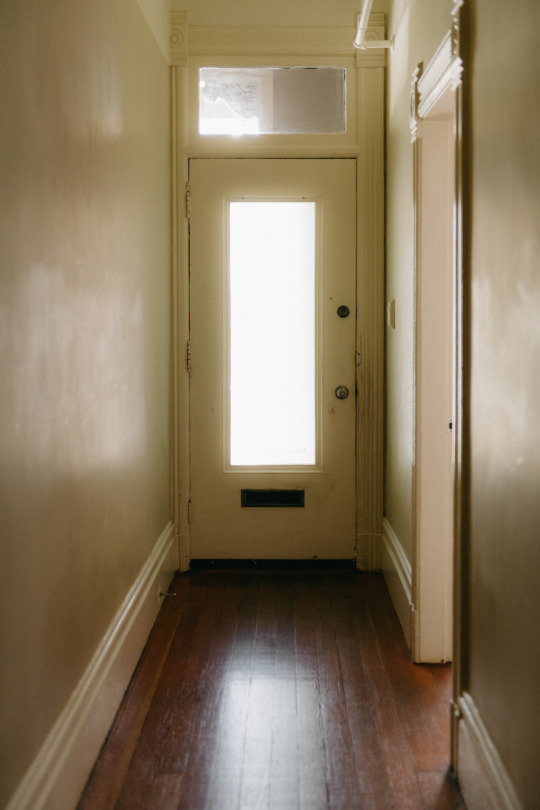

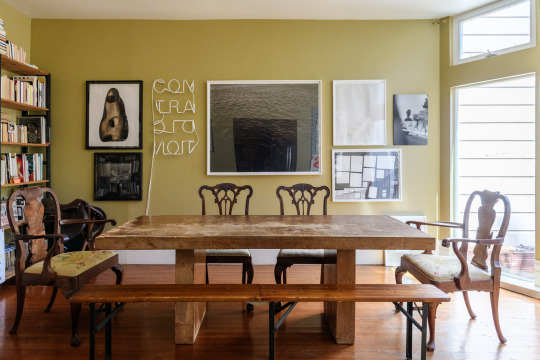



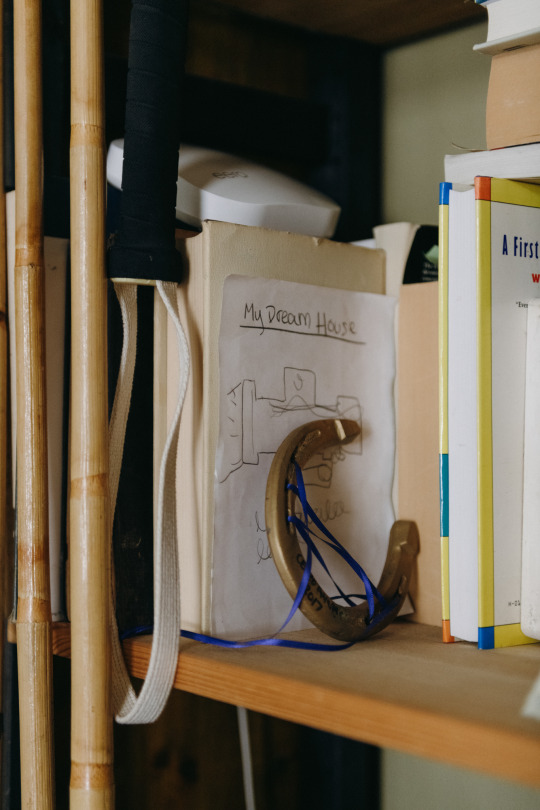


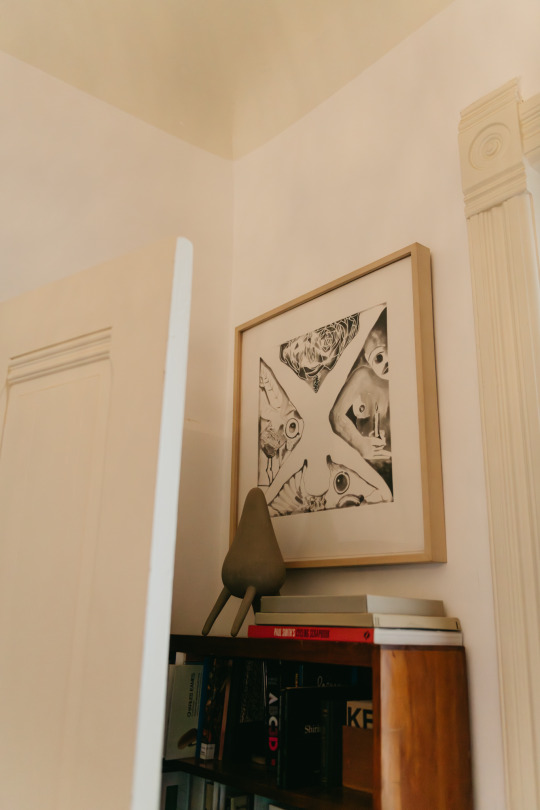
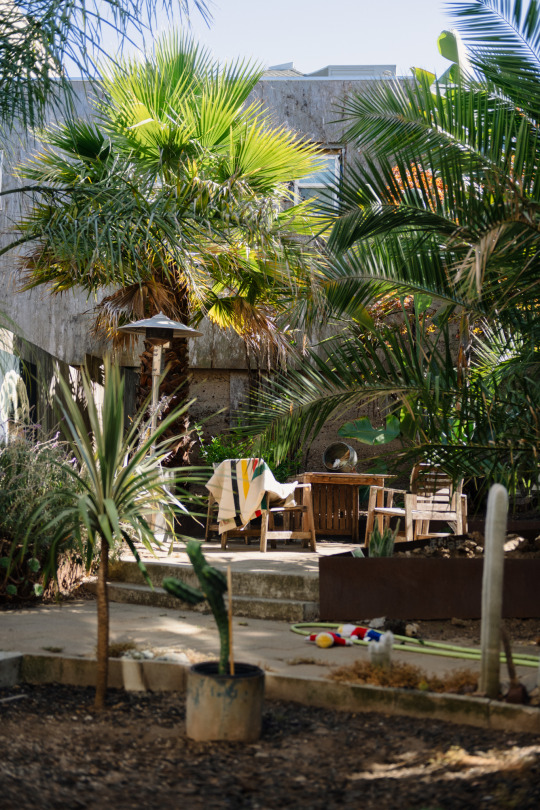
1 note
·
View note
Photo

Save the date!
A week from today is the digital tour of Co-Terminous with curator Erin Espelie. Mark your calendars to join here from 5:00 to 6:30 PM (Mountain Time) on January 6, 2021. Oh, by the way, the fun fact is not completely true. A dowel rod runs down the center and there's a wooden base hidden in the bottom "rock."


Image Credit: Balance, 2020 | Acrylic on papier-mâché, wood and newspaper | Dimensions variable
#unionhall#unionhalldenver#denver#colorado#art#visitdenver#coloradoart#museum#artactivism#artandecology#fortcollins#coloradoartist#recreateresponsibly#contemporaryart#papiermache#sculpture#cairnbuilding#leavenotrace#cuboulder#nest#nestcuboulder#artivism#digitaltour#savethedate
1 note
·
View note
Quote
Cinema had its start in a search for an empirical answer: Do all four of a horse’s feet leave the ground when it runs? The animal-locomotion work of Muybridge, bird flight for Marey, insect studies for Percy Smith, and actuality films by the Lumière brothers. That empiricism was followed quickly by narrative, typified by D.W. Griffith and Méliès. Yet cinema arose out of the science of looking, to know in the empirical fashion. In short, these references boil down to the thing vs the idea or description of the thing. I like to look at the former and roll around formulations of the latter. I am interested in creating a sensorial thought experience, finding novel passages for navigating the density of life.
http://www.vdrome.org/
0 notes
Text
Dissolution, transformation, coagulation

Scotland in spring is a place of magic, especially when you add the enchantment of the moving images. Back from Hawick and Alchemy Film And Moving Image Festival, Rohan Berry Crickmar shares his lush “alchemical visions” in an equally lush travelogue. Time to put your film-walking shoes!
Alchemy Film and Moving Image Festival has been bringing an excellent selection of artist and experimental film and installation work to the Scottish Borders since 2010. Initially founded through the co-operation of the Scottish charity Alchemy Film & Arts, the Creative Arts Business Network, and the council-run arts venue Heart of Hawick, the festival has been presided over by its Creative Director Richard Ashrowan, who is also involved in Scotland + Venice for this year’s Venice Art Biennale. The event seeks to showcase as wide a selection as possible of contemporary artist and experimental films, and also organizes residency programmes at the Moroccan cultural retreat centre Café Tissardmine. This year’s theme was fixed to the idea that informs the name of the festival itself – alchemy and the alchemical. Ashrowan and his programming team were expressly interested in films that explored the idea of alchemical vision in film and moving image. To that end the selection that they put together reflected a full range of creative possibilities and approaches embodied within the flux and mutability of the alchemical.
Despite having been back in Scotland since 2013, and living in Edinburgh (just 90 minutes, or so, from Hawick), since mid-2015 this was the first opportunity I have had to get down to Alchemy. It has always fallen a little too soon after my annual visits to Rotterdam and Berlin, and even with its relatively close proximity it has felt more difficult to get to somehow. Being one of those carbon-footprint-conscious souls who has resisted the pull of the private car, public transport would become the sole dark cloud to hang heavy over the weekend. My original plan was to attend Saturday and Sunday of the festival, staying overnight to maximize the later Expanded Cinema events on Saturday night. However, some work issues meant that I had to look at Friday and Saturday instead, returning to the festival on Sunday in time to see the Scottish premiere of Karolina Breguła’s minimalist opera THE TOWER / WIEŻA (2016).

Izabella Pruska-Oldenhof, Erin Espelie, Joost Rekveld, Semiconductor; images: courtesy of Alchemy
Still, due to the kind offer – the first of many little kindnesses over the course of the weekend (a press pass from the Festival Producer Harriet Warman) – I was able to also attend the Artists’ Filmmaking Symposium on the opening Thursday of the festival. The festival programme was full of intriguing material, with over 120 films screening in some capacity or another over the course of the five days. I was able to see barely a handful of the things that were on offer, yet even the small selection that I saw left an indelible mark. Undoubtedly, the Symposium event was a crucial way of opening out the festival and its thematic concerns. It introduced me to two artists that I had not come across before: Izabella Pruska-Oldenhof (a last minute replacement for Violaine Boutet de Monvel) and Erin Espelie. It was also an opportunity to reacquaint myself with Joost Rekveld’s singular works of machine-mediated matter, as well as the tangentially related digital-noise experiments of Semiconductor (with Ruth Jarman giving the final talk).
I knew what to expect with Rekveld, as I had just seen #67 (2017) premiere in Rotterdam, accompanied by two substantial talks about his work and working practices. In December of last year, at the Alternative Film/Video Festival in Belgrade, I had been able to enjoy a short showcase of Dutch experimental film curated by Simona Monizza of the EYE Filminstitut, Amsterdam. This was my first encounter with Rekveld in over a decade, and it had made me eager to gorge myself on his most recent experiments with analogue computers and how they can help to capture externally produced sound as visual data.
Likewise, with Semiconductor, I had first come across them at the International Festival of Contemporary Arts in Slovenia in the summer of 2003, where they performed a piece called STRATA (2002), a 3D animated real-time landscape, replete with sound effects triggered by the animation. Since then I had not kept abreast of their (Joe Gerhardt being the other half of the partnership) more recent output. Ruth Jarman’s Symposium presentation, focusing in particular on EARTHWORKS (2016) and BLACK RAIN (2009), made me acutely aware of what I had been missing. Over the past decade, the duo had found their work increasingly taking them into science labs “to make films that help us to explain the material world.” For example, on EARTHWORKS they were utilising seismic data and the way in which that data is visualized to create beguiling animations and soundscapes that seemed to evoke the slow and powerful frictive shifting of the Earth’s surface. Jarman also drew attention to work that they had been doing at the Smithsonian in recent years, where they had come across films that scientists had been making about their experiments and discoveries, going as far back as 1915. What really struck me about Jarman’s talk was the way in which she talked about Semiconductor’s approach to the scientists themselves. The team had become increasingly interested in the language of the scientific, and how that niche tongue could be untied and made more discernible through artistic experimentation and expression.
Colorado-based Erin Espelie came as something of a revelation to me. Her precisely structured and engaging presentation took the audience through her back-catalogue of film work, hinting at her scientific background and drawing upon a reservoir of memories linked to her father’s career as an entomologist and her own youthful experiences of the natural world. What was most striking about her work was the way it melded together expertly poetry, science, film aesthetics, and personal emotional responses. This was film as a truly promiscuous and polyvalent medium, and nothing seemed to capture this better than her 2014 collection of short films THE LANTHANIDE SERIES. In this series, Espelie wed together the idea of rare Earth elements (which are found within the Lanthanide grouping of the periodic table), contemporary digital technology, how we see, and the ecological impact of this seeing. By filming upon portable digital screens (all of which are made possible through the the industrial use of rare Earth elements) and obsidian mirrors, Espelie was explicitly demonstrating how the image is founded in material reality, even when digitally rendered. I have not come across a more impressive image-maker, and one whose images possess, or are possessed, by a world concretizing depth and density.
Izabella Pruska-Oldenhof’s seeming reaction against the new digital dominance within the moving image took on an extreme materiality, subtly masking a remediation as digital artefact. Her installation work for the festival IN MEDIA RES (2015) was composed of photogrammic images of bodies down through centuries of art, structured in such a way as to form a larger mosaic image. Thus, the fragmentary is foregrounded within the presentation of the whole. This material presentation was accompanied by the capture of 16mm spooling film into glass-encased instant sculptures. Then video projections adorned both walls, with the edit of the image creating a glitchy sound design. The photogrammic images were actually constructed via digital means, thus presenting within one space an extensive media archaeology (mosaic, photogram, celluloid, video). As much as I enjoyed her work, the presentation was perhaps the most difficult to fully comprehend.

Thought Broadcasting, Omen, Swings and Roundabouts, Buccleuch Church on the Kirk Burn; images: courtesy of Alchemy
After the Symposium, the festival team put on a series of tours of the various installations within the town. I was fortunate enough to be in a group that had the affable Gateshead-born film critic and programmer, Michael Pattison, taking us from the various snugs, shops, and industrial spaces that housed the works. Hawick has a lot of woolmakers and old industrial architecture associated with textile production. Some of these buildings are still very much in use, whereas others have been abandoned (in a few cases – quite recently and possibly reflecting the economic downturn felt in many parts of the UK since 2008). Each of the spaces had been adapted and modified by the artists whose installations were located within them.
In its most effective manifestations, this meant that the space was transformed into something entirely different, such as in the case of Nick Jordan’s THOUGHT BROADCASTING (2016), in which some of the bureaucratic blandness and industrial sterility of British clinical spaces and British broadcasting studios were suggested through careful arrangement of projected image, found object, and archived material. Similarly, Nazare Soares piece OMEN (2016) converted an upstairs factory room into a darkly ritualistic space of shamanic séance, replete with reclining, hammock-style chairs, that left you lying close to the ground in a strangely transfixed state of readied receptivity.
I must make brief mention of two other delightful installations. Jessie Growden’s playful SWINGS AND ROUNDABOUTS (2016) presented a room with Spirograph elements dangling from the ceiling and a film looping round on a small television set. The film was entrancing, as it found circular patterns in nature (whirlpools and eddies), then had the artist carrying out cyclical activities (the drawing of a spirograph images) and disrupting these cycles through the reversal of the image at points where this initially goes almost unnoticed. The puckish quality of the work was a neat juxtaposition against Soares’ more fugue-like installation on the part of the festival organizers, as both artists inhabited the same space, but with entirely different energies and effects. Finally, Jacques Perconte’s mesmerising loop BUCCLEUCH CHURCH ON THE KIRK BURN (2016) was a layered video image that played with the colour distortion possibilities of video to create an intensely psychedelic and ruminative experience of place, with Ettrick Forest and the Buccleuch Church forming almost fractal-like compositions at the loop’s most expressive moments.

Non-Places: Beyond the Infinite, On a Wing and a Prayer, Second Hand Daylight, Maelstroms; images: courtesy of Alchemy
Getting back down to Hawick for the main closing events of the Sunday, I was able to catch an assortment of shorts, screened in the makeshift cinema / screening room in the office spaces of the Heart of Hawick. There is a real pleasure to be found in the dexterous way in which the festival organizers infiltrate and modify so many different parts of this complex and the wider town. I was pleased to note that the programmers had picked up on Péter Lichter’s masterful NON-PLACES: BEYOND THE INFINITE (2016) from Coos & Chemicals that takes Marc Augé's essay Non-Places: Introduction to an Anthropology of Supermodernity plus Cioran’s philosophical obsession with decay and uses them to underpin a minimalist inversion of 2001: A SPACE ODYSSEY (1968). I had seen this film at the Alternative Film/Video Festival in Belgrade and wrote about it (for another publication) as one of the standout films of that festival.
ON A WING AND A PRAYER (2016) by Alia Syed from Uncertain Territories was a timely intervention into the discussion about UK asylum laws. It is ostensibly documenting the journey that Abdul Rahman Haroun took, on foot, through the Channel Tunnel. The filmmaker chops up this journey into disorienting and seemingly repetitious POV tracking shots that convert this passage into some looping nightmare of fear and paranoia (tellingly, the footage is so dislocating that the fact it is actually shot within the Rotherhithe Tunnel does not really matter). All the while a voiceover reads out the procedures of the UK asylum policy and extracts from The Malicious Damages Act of 1861, which Haroun would be charged under on gaining asylum in the UK. The inhumane language of legal protocol is foregrounded by the emotional immediacy of Syed’s tunnel footage in a trenchant critique of our border controls.
Simon Aeppli’s SECOND HAND DAYLIGHT (2007) was another powerful political work on display in the from Uncertain Territories strand. An exceptionally well edited digital film approximation of a scrapbook, replete with collage effects and the filmmakers’ actual scrapbooks, it explores the paranoia of the Northern Irish troubles in a way that was vacillated wildly between moments of sharp humor and moments of unsettling portent. Another work that complemented these politically charged pieces was Lana Z Caplan’s MAELSTROMS (2015) from Reasons to Be Anxious, Part 3 – a harrowingly intense look at how modern surveillance imaging creates a dehumanizing gaze. The film cuts between US border-patrol footage, drone footage, and various other forms of surveillance, all of which are presented in disconcerting shades of grey, like a negative transfer. I was lucky enough to be sat beside the filmmaker at Aeppli’s screening, and in our brief conversation afterwards I was not surprized to hear that she found his film to be particularly powerful.

The Tower, Fluid Dynamics, Performance, Incident Reports; images: courtesy of Alchemy
The final day neatly brought together proceedings with three presentations in the main auditorium of the Heart of Hawick. Karolina Breguła’s stunningly simple and surprisingly effective experimental opera THE TOWER has gone through various different versions since its first appearance in early 2016. The version screened at Alchemy was the 79-minute edit, that features the rather abrupt ending and tactile post-credit coda. Breguła is a film artist increasingly aware of Polish film history, and her decision to film an opera in a style comparable to the state-funded documentaries of the likes of Jacek Bławut or Krzysztof Kieślowski gives THE TOWER a curiously contradictory atmosphere of specificity and universality, the quotidian and the magical. As a residence group within a block of flats seeks to build a new space from sugar, their dreams range from utopian living quarters, to a model modernist city, to the eventual reconfiguration of the human body through a realignment with the crystalline structure of sugar. The music is composed by the Oświęcim-born, Glasgow-based electronic musician Ela Orleans, who was present for a Q&A.
Later in the afternoon, the Nature Spirits collection was a fascinating showcase for the diverse talents of artists such as Robert Todd, Jason Moyes, and Charlotte Pryce. Todd’s film FLUID DYNAMICS (2016), which was receiving its world premiere, was the perfect way in to this programme. Through the meticulous use of different aspect ratios and types of shot, Todd creates an apprehension of a natural environment that, first of all, calls upon the viewer to be attentive to the image, in a way that drew me closer to the filmmakers’ actual experience of that environment. Later on, the film begins to fall in to a reciprocal relationship with the natural flows of water and plant matter, the rhythms of the place fuse Todd’s camera into a dance with nature. This exhilarating interlude is then recontextualized when the filmmaker places himself into certain sequences, turning the attention away from the immediacy of our relationship, as viewers, with the film, and placing back upon the filmmakers’ relationship with seeing and feeling the environment he inhabits. This approach was echoed in minimalist fashion in Lea Petrikova’s PERFORMANCE (2015), wrapping the Nature Spirits screening. A camera captures a landscape twinned in the reflection of a lake. It is a stunning natural vista, caught in the lowlight of the gloaming. Petrikova moves the camera so gracefully that it creates a beautiful tension when human figures begin to pull in front of it. Gradually, it is revealed that an audience is gathering upon the lakeshore, and as Petrikova pulls the shot steadily backward over the crowd, a faint murmur of melody and drum can be heard, but the real performance has been in front of our eyes all along.
The closing feature of the festival was the wry Canadian filmmaker Mike Hoolboom’s deeply humane feature INCIDENT REPORTS (2015). Ostensibly a film in the form of a series of reports to an unseen therapist, Hoolboom dissects the contemporary Canadian culture that he inhabits, mourning the disappearance of books and bookstores, embracing the joyous and life-affirming street performances of naked cyclists or revellers at a downtown music festival. Hoolboom consistently interrogates our contemporary notions of a trans-postmodernity that has gone beyond affectation until it inhabits a genuine permissiveness, that is both honest, non-judgemental and accepting. A bit like the films of Roy Andersson, Hoolboom tends to lock the camera down in a fixed position and let things play out in front of the camera. In so doing he is extending the inclusiveness of his vision, failing to privilege or preference any one figure within the frame. This framing also enables him to use a characteristically deadpan voiceover narration to create gentle comedy from what is being observed. The entire film is shot in a color palette that makes reds, yellows, and greens dominant, the final joke of the film comes with the musical revelation of this color scheme.
In the immediate aftermath of the Hoolboom screening, as Richard Ashrowan closed off proceedings by bringing all the members of the festival team and volunteers up on stage to receive a standing ovation, I was made palpably aware of what kind of space this festival had managed to create here in a quiet, predominately working class, Scottish Borders town. Perhaps, I had been trans-fused with inclusive warmth of Hoolboom’s alchemical vision, but it really felt as Alchemy had created a warm, safe, and open space, in which creativity could be shared rather inspiringly. This was truly palpable, and then palpably political, as with all of the myriad divisions, ruptures, and ructions that had taken place globally over the past eighteen months. With a resurgent bigotry and chauvinism seeming to gird the political ideologies of governments within Europe and North America, here was quietly assertive countering of these hostile energies. A demarcated space that was only demarcated because it chose not to traffic in exclusivity. All of this came as a shock to me, for my own prejudices have probably read an exclusivity within such festivals based upon a failure to see them reach out and bring experimental film to a wider audience.
Yet at Alchemy, at the close of the festival, it felt like they had got so much right. From the close proximity to artists and filmmakers, through to the innovative ways of engaging audiences with such works, through to the festivals relationship with the town itself. On leaving the Heart of Hawick. I happened upon a few groups of kids and teenagers killing time in the quiet of Hawick’s main shopping street on a Sunday evening. The kids were huddled in disparate groups, chatting, messing about, having a laugh. I could not help but think that they were missing something, though, something right on their doorstep. I did not want to let go of the blissful feeling that had come over me, but I could not ignore the nag at the back of my head, were the kids missing something, or was there still something more that Alchemy could do to truly realise its vision(s)? Perhaps, Andrew Kötting’s Monday film-walk to the nearby Hermitage Castle would interrogate this gap unseen, now revealed. The space between what was, what is, and what could still be. Or maybe that is asking far too much of Andrew.
vimeo
#Alchemy Film And Moving Image Festival#Alchemy2017#IFF Rotterdam#Berlin IFF#Berlinale#Alternative Film/Video Belgrade#experimental cinema#avant-garde#video art#short films#installation#opera#Richard Ashrowan#Izabella Pruska-Oldenhof#Erin Espelie#Joost Rekveld#Semiconductor#Nick Jordan#Nazare Soares#Jessie Growden#Jacques Perconte#Péter Lichter#Alia Syed#Simon Aeppli#Lana Z Caplan#Karolina Breguła#Mike Hoolboom#Andrew Kötting#festival report#Rohan Berry Crickmar
0 notes
Photo

Subterranean Cinema: A Return to the Geo-Imaginaries of the Hollow Earth
LEK AND THE DOGS
By Erin Espelie
1 note
·
View note
Photo

Millennium Film Journal No. 60 “World Views” (2015). Out of print. PDF files available through link in bio. Posted frame enlargements from the issue by Rebecca Myers, Erin Espelie, Chris Welsby. #mfjbackissue #millenniumfilmjournal . . . . . . . . #artistsmovingimage #experimentalfilm #movingimageartists #rebeccamyers #erinespelie #chriswelsby #howardguttenplan #pattychang https://www.instagram.com/p/BpmqCQLFpAB/?utm_source=ig_tumblr_share&igshid=15hs0as9poc7y
#mfjbackissue#millenniumfilmjournal#artistsmovingimage#experimentalfilm#movingimageartists#rebeccamyers#erinespelie#chriswelsby#howardguttenplan#pattychang
0 notes
Link
0 notes
Photo




The Nightingale welcomes Erin Espelie to present her experimental documentary about rare earth elements (the lanthanides), black mirrors (from obsidian to iPads), and how technology is reshaping the way we record the present and replay the past.
From the portals of personal computing devices to ancient obsidian mirrors, optical tools control how people see, foresee, record, and remember their lives. The Lanthanide Series ( 2014, USA/France/UK, 72 minutes) meditates on how we frame and understand the world through such material means and instruments, with a reliance on certain chemical elements and the people who we love.
#Erin Espelie#documentary#environmental#essay#experimental#found footage#geography#history#landscape#poetry#science#uncategorized#video
1 note
·
View note
Text
Gratitude
This Thanksgiving I am grateful to have my work included in the exhibition “Co-Terminous” at Union Hall!
“Amy Felder reminds us with Balance (2020) that rocks perform directive feats, too: her precarious-looking cairns are objects typically maintained in the wild by mutual generosity. Yet Felder’s cairns are made of mere paper, pointing to futures that may not be able to withstand any more weight, relics lacking mineral substance.” - excerpt from curator Erin Espelie’s essay on “Co-Terminous”
While Union Hall has had to temporarily close its doors due to new safety measures, be on the lookout for upcoming virtual events. Visit unionhalldenver.org for more information and to see some great photos of the exhibition!
#unionhall#unionhalldenver#denver#colorado#artmuseum#artactivism#art#coloradoart#cuboulder#nestcuboulder#artivism#gratitude#virtualevents
1 note
·
View note
Text
Digital Tour of Co-Terminous
Today is the digital tour of Co-Terminous with curator Erin Espelie. Join here from 5:00 to 6:30 PM (Mountain Time)!
Also, the last day to see the show in person is Saturday, January 9, 2021.
#unionhall#unionhalldenver#denver#colorado#art#visitdenver#coloradoart#museum#artactivism#artandecology#contemporaryart#artivism#digitaltour
0 notes
Text
“Co-Terminous” Reopens Today
Union Hall is reopening "Co-Terminous," beginning today through January 9, 2021. Make a reservation on their website to visit in-person. Please also note the change of date for the upcoming digital tour with curator Erin Espelie. It is now scheduled from 5:00 to 6:30 PM (Mountain Time) on January 6, 2021. Click here to join.
#unionhall#unionhalldenver#denver#colorado#art#visitdenver#coloradoart#museum#artactivism#artandecology#fortcollins#coloradoartist#contemporaryart#cuboulder#nest#nestcuboulder#artivism#digitaltour#reopening
0 notes
Photo





"Co-Terminous" is on view at Union Hall through January 9th! However, if you're unable to make it in-person, join us for a Curatorial tour of Co-Terminous with Erin Espelie on December 16 from 5:00 to 6:30 PM. Also, Union Hall presents: Straight White Teeth, a digital musical performance located in the exhibition space on November 18 from 7:00 to 8:00 PM. For more information about the exhibition and upcoming events, please visit unionhalldenver.org.
Image Credit: Balance, 2020 | Acrylic on papier-mâché, wood and newspaper | Dimensions variable
#unionhall#unionhalldenver#denver#colorado#art#visitdenver#coloradoart#art museum#artactivism#artandecology#fortcollins#coloradoartist#nationalpark#recreateresponsibly#contemporaryart#papiermache#sculpture#cairnbuilding#leavenotrace#cuboulder#nest#nestcuboulder#artivism#digitaltour#digitalperformance
0 notes
Video
vimeo
Erin Espelie, What Part of the Earth is Inhabited, 2009
0 notes